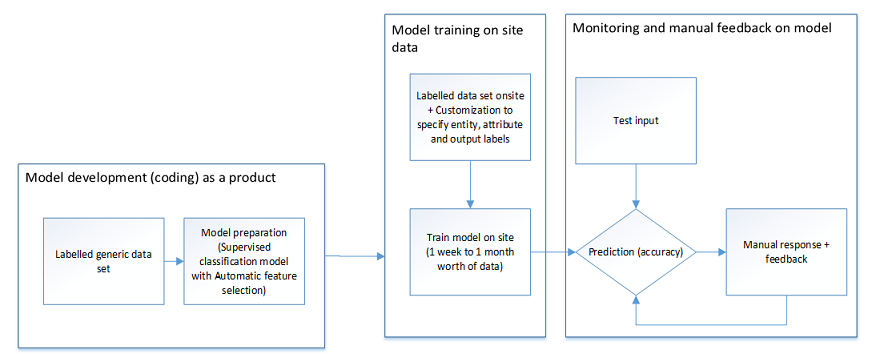Machine learning implementation strategy for a customer service center
With digitization of almost all industries on the way, advanced technologies like machine learning are revolutionizing the way of work for most industries today. Many customer service centers are already thinking about adopting machine learning for their day to day operations and these techniques will soon be a part of industry standard best practices. It is therefore imperative for all call centers to adopt new age technology for improving their performance metrics and to stay competitive.
This post describes how traditional call centers can create a strategy for adopting machine learning capabilities by evaluating the technical capabilities offered against their KPIs.
Every customer service operations manager has the following business goals in mind-
- Reducing cost of operation in terms of people or time
- Improving customer experience and hence customer satisfaction
To achieve these goals, most call centers will be tracking one or more of the below KPIs-
| KPIs | Business goal |
| Average Handling Time | Cost reduction |
| Case resolution time | Customer experience |
| CSAT (customer satisfaction score) | Customer experience |
| NPS (Net Promoter Score) | Customer experience |
| Customer effort | Customer experience |
| Case deflection rate | Cost reduction |
| Number of support cases created | Cost reduction |
| Average wait time | Customer experience |
| First call resolution | Customer experience |
| TAT (Turn Around Time) | Customer experience |
Customer service leads can leverage various machine learning capabilities to meet these KPIs. Below are some of the use cases of machine learning that can be applied to common traditional call center processes.
Machine learning capabilities for call centers-
- Task automation – Manual tasks could be replaced by machine learning based task automation.
- Issue classification for incoming requests – Currently, a lot of call centers have agents manually classify the issue type after going through the case or communication details coming in through various channels like email, portal, phone and chat. Some call centers have a gatekeeper, who goes through the requests and manually categorizes the requests to the right department. This process could be automated using machine learning.
- Intelligent routing to agents– Most call centers use automatic routing to direct incoming requests to agents based on agent capacity and availability. ML based models that help route in real time based on similar cases resolved in the past or behavioral matching between the agent and the customer can help make the process more efficient.
- Automatic case assignment – Call centers have supervisors assign cases to agents. Case assignment could be automated and based on similar cases handled in the past.
- Automatic data capture– After every call/chat or offline communication, agent is supposed to fill out case information to complete after call work. This is a time- consuming exercise. Natural language processing can help automatically populate case information for an incoming request by accurate classification of information as title, subject, customer details, call notes and next steps as tasks.
- Automated email responses– Instead of agents replying to every email, machine learning can help understand the query by doing issue classification using text analytics and replying with a mapped email template.
- Agent guidance/agent productivity
- Similar cases suggestion using text analytics – If an agent is working on a case it will help for him to know what other similar cases were resolved so that he can follow a guided process to resolve the query. Machine learning can help determine semantic similarity between the current query and other cases to suggest a solution.
- Relevant KB article suggestion – A KB article that has already been sent for a similar case and helped resolved the issues can be forwarded by agent in the beginning of the interaction and is likely to resolve the customer issue faster.
- Next best steps suggestion – There could be some agents that are more skilled and experienced in the call center and some others that are new recruits. Few call centers have subject matter experts that are available on the floor to provide guidance to agents when they need help. A machine learning system can recommend the next best step to a novice by comparing the journey path of current case to other similar cases and recommend steps like send KB article via preferred channel, transfer to a different department, escalate to superior, fill information on case form, search CRM for information or search an external system. This will help the agents handle customer queries more confidently.
- Customer effort reduction
- Auto detect customer intent – For a customer who is using the portal or has had a communication through any of the other touchpoints, ML can help find similar journeys for the current customer journey. This will help predict the customer intent when they reach out to a call center hence eliminating the need for the customer to explain the issue to the agent
- Proactive notifications for engagement with customers – Based on the customer journey, ML could be used to predict the possibility of contacting customer service. Proactive notifications could be shown to the agent regarding the same.
- Suggest preferred channel– ML could be used to predict the right channel to reach out to the customer for a particular issue type.
- Suggest preferred time – ML could help predict when is the customer most likely to be available.
- Case deflection
- Auto-suggest self-help steps – Based on customer journey, ML could predict similar customer journeys and help predict the next steps.
- Chatbots – chatbots can help answer the most common simple queries and hence help reduce the volume of customer queries.
- KPI prediction
- Case resolution, NPS, churn rate prediction – ML can help predict the important KPIs for a case. This can help agent and supervisors take necessary steps to ensure that the KPI has been correctly met.
- Customer sentiment – Text analytics can help predict sentiment in real time for an ongoing interaction. This information will help the agent take necessary steps to ensure that the customer is happy.
Which capabilities are the most effective for an organization and give the best ROI will depend on various factors like the call center structure, KPIs tracked and implementation challenges. We should note that each KPI improvement drives improvement for other KPIs as well. E.g. If the AHT goes down it will also indirectly have a positive impact on CSAT as customer queries will be resolved faster. Below is a look at various machine learning capabilities and the impact that these will have on KPIs.
For understanding the ROI let’s assume a call center with 500 call center agents with a call volume of 15 per agent per day.
| Machine learning/AI capability | Business metric impacted | Business goal | Impact | SMB | ROI |
| Automate tasks | |||||
| Issue classification for incoming requests | Reduces TAT, improves accuracy of classification | Customer experience | Medium | No well defined processes in SMB- trivial task for them | Reduce TAT by 0.5 days on an average, improves accuracy of classification by 5-10 % on average and eliminates manual error |
| Intelligent routing of incoming requests based on criteria like similar cases resolved | FCR goes up due to lesser transfers, AHT goes down | Customer experience, cost reduction | High | Not many agents available | 5-!0% increase in FCR for call centers with different issue types and complex queries, AHT goes down by atleast 5 minutes spent gathering case information (625 man hours for our example call center) . |
| Intelligent routing using behavioral matching | CSAT | Customer experience | High | Not many agents available | CSAT will go up significantly, dissatisfied customers less by 5-10% minimum. |
| Automatic case assignment | TAT reduction | Customer experience | medium | Not many agents/cases, depts. – trivial task for them | Reduce TAT by 0.5 days on average |
| Automatic capture of case information on case form with accurate categorization of case title, subject, customer information, call notes, next steps | Reduces time spent for filling case information thus freeing agents for answering customer queries | Cost reduction | medium | SMB- medium priority |
2 minutes spent capturing case information per call. Cost savings of 250** man hours per day on average
|
| Auto-response through emails based on issue classification/identification | Reduces time spent in parsing and responding to emails | Cost reduction | High | Useful for SMB | Cost savings of 2400*** man hours per day |
| Guide agents/ Agent productivity | |||||
| Similar cases suggestion using text analytics | FCR will go up, AHT goes down | Cost reduction, customer experience | High | Useful for SMB | 10 minutes spent in researching per call will not be required. Cost savings of 1250 man hours per day. |
| Relevant KB article suggestion for cases | AHT goes down as agents can serve relevant KB articles faster, FCR goes up | Cost reduction, customer experience | High | Useful for SMB |
Cost savings of 10 minutes per call (1250 man hours per day on average for a call center with 500 agents)
|
| Next best step suggestion | AHT goes down, FCR is better as the agent is guided to next steps and does not need to transfer calls or consult before answering a customer query | Cost reduction, customer experience | High | Useful for SMB | 10 minutes spent (1250 man hours) in a call consulting an SME will be reduced. FCR up by 5-10% on average |
| Reduce customer effort | |||||
| Auto-detect customer intent for an incoming request | Improves customer’s experience as he does not have to explain his problem again | Customer experience, cost reduction | high | Useful for SMB | CSAT up by 0.04 on a 5 point scale, dissatisfied customers less by atleast 5-10%****. Cost reduction of 2 minutes spent gathering case information (250 man hours per day) |
| Proactive notifications for engagement with customers e.g. chat on portal | Delights the customer by reaching out to him at a stage where he might need help | Customer experience | medium | CSAT, NPS will be positively impacted | |
| Suggest preferred channel and time of engagement | Delights the customer by reaching on preferred channel and time | Customer experience, cost reduction | medium | CSAT will be positively impacted, cost savings from calls where customer was not available | |
| Case deflection | |||||
| Auto-suggest self-help steps to customer based on natural language processing of customer queries | Reduces the volume of cases handled | Cost reduction | high | Useful for SMB | 60% reduction in case volume, 2400 man hours in cost savings |
| Chat bots for customer queries | Reduces the volume of cases handled | Cost reduction | high | Useful for SMB | Bring down case volume by over 60% |
| Predict and measure KPIs | |||||
| Case resolution time, sentiment, NPS, churn rate | Helps agents/managers take necessary steps to track and achieve KPIs | Customer experience | medium | Helps to achieve KPIs |
*Assuming issue classification by a manual gatekeeper takes 0.5 days on an average
**Assuming 2 minutes spent on the activity per agent per case (2 minutes x 500 agents x 15 calls per day = 250 man hours)
***Assuming like most organizations, 60% of the requests are driven out of customer queries that are simple in nature and do not need manual intervention like status updates, product information, tier 1 queries. Cost saving = (60% of (500 agents x 8 hours) = 2400 man hours)
**** CSAT is measured as number of customers who are satisfied out of the total list surveyed. On a 5 point scale and a benchmark of 4.1 or 80% satisfied customers a case volume of 1 lakh cases per month and a response rate of surveys as 5%, one of the top reasons for customer dissatisfaction is having to repeat information. Assuming reduction in dissatisfied customers by atleast 5-10%, the CSAT score will increase by 0.04)
The metrics that are important for a service organization will depend on a number of factors like the size of the organization (50-100 employees to >100 employees), the domain that the business caters to like finance, healthcare, retail, travel, hospitality etc., does the organization have an existing CRM implementation, does it have the data that is required for it to get started, channels used for support by the organization, is the call center outsourced or in-house amongst other factors.
Business factors (cost, domain) that define how various call centers are different-
| Size of support org | Volume of queries/agent | Business Vertical (Finance, healthcare, retail, travel, hospitality etc.) | Outsourced vs in-house |
Other factors that are decided by IT of the support organization with business
| Channels used | Channels – high touch vs low touch | Well defined structure within the support org | KB article repository | Training resources for agents | Well defined processes for handling queries |
Taking a few examples below of typical call center setups-
SMB (Small and medium scale businesses)
For example, the support org of an SMB will be characterized by
- Small number of employees (10-20)
- Not a very high case volume (200 per day max.)
- No well-defined processes
- No team segregation or well-defined departments to handle different types of issues
- There might not be a lot of training resources for the call center
- No pre-existing CRM implementation or structured data, whatever data exists might be present in disparate systems
- No pre-defined knowledge base of articles.
- More low touch channels to cut down on support cost.
An SMB will think about CRM implementation when the volume of queries becomes difficult to handle without it. ML and AI application KPIs that might be more relevant for an organization of this nature will be –
- Chatbots will help handle simple queries when agents are not available. This will reduce case volume and allow a small call center to handle queries efficiently.
- Agent productivity capabilities like similar case suggestions, next best step suggestions and KB suggestions will bring down the case handling time and allow a small number of agents to handle a larger number of support queries. These solutions are helpful also because the agents will not typically have a lot of training resources or training time available.
- Self-help portals with KB suggestions
- The organization in its early stages gives a lot of importance to customer experience because you care about CSAT, NPS and basically you don’t want to lose any customers. It’s important to not lose track of or disappoint any customer. So, ML capabilities like being able to predict the customer’s intent when he reaches out to support after browsing content on the portal are important to provide a satisfactory experience.
Insurance
An insurance customer service org is a perfect example of a support organization that cares most about CSAT and repeat purchases with a few unique characteristics –
- Insurance business earns customers out of its repeat business so customer satisfaction, customer experience and low churn rate is critical for it to retain customers.
- An insurance business will also be an outbound call center mostly.
- The main channels of support will be high touch like voice or in-person to give a personal touch to the relationship with customers.
The ML/AI capabilities useful for a customer service center in insurance will be-
- Since good customer experience is a key pivot for an insurance organization to be successful, ability to predict customer intent when he reaches out to support is one of the key capabilities that will help drive a higher CSAT and reduce customer effort. So, it is very important for an insurance organization to have this capability.
- Proactive engagement requests to customers based on predictions that the customer might need help with e.g. when surfing the portal or when a policy is about to lapse is important.
- Intelligent routing to match the right agent to the customer will help achieve a higher CSAT.
- Knowing the right preferred channel and time of engagement will help ensure that the outbound call center is reaching out to the customer at the right time. E.g. when an insurance agent reaches out for a policy renewal they should do so when I am using my desktop and have access to internet to renew the policy for maximum probability of me renewing the policy.
- It is very important to track important metrics like churn probability, case resolution time, customer sentiment etc. to ensure that a good experience is being provided.
- Agent productivity ML capabilities will also help improve customer experience along with providing a good FCR.
Once the service org decides as to what are the key areas of investment for implementing machine learning capabilities from a business and KPI perspective, they might need to look at pre-requisites in terms of data and systems along with implementation challenges. Below is an example of how an issue classification ML model can be implemented on a call center site.
Issue classification – Phases of implementation in a call center using available models:

The service org can decide to either create a model of its own from scratch or deploy an existing model from any of the products available in the market. Building a model from scratch will need expertise in the area of data science and machine learning and since this is generally not a skill set available in a customer service /IT organization, a more viable option will be to use an existing product from the market to meet the service organization needs. At this point it is important to choose a product that has capabilities that require minimal customization and no prior data science knowledge. In the above example of issue classification, the model has been coded and trained on a generic data set and incorporates advanced ML techniques like automatic feature extraction and automatic selection of appropriate data classification models to be chosen to give maximum accuracy. The steps required by the call center IT team to implement this model would be-
- Customize the product to point it to the input data set (labelled in this case) and output column. No prior data science knowledge is required and this is hence a low customization effort.
- Train the model using at least 1 week – 1 month worth of data based on per day data volume. If the call center already has an up and running call center and the data is available, no lead time will be required to train the model. If, however, it’s a new data center, a lead time of 1 week to a month will be required to capture the data.
- Once the model has been trained, it should be monitored for accuracy by a domain expert or a user for at least 1 week to 1 month. The time taken will depend on how fast the model is able to yield accurate results.
Once the model has been trained, it should be possible to use it in day to day operations to increase productivity and lower costs.
Capturing below implementation challenges that might exist while applying an ML solution to the call center.
| Machine learning/AI capability | Data pre-requisites | Model deployment | Appropriate model | Domain specific | Customization | |
| Model training | Monitoring | |||||
| Automate tasks | ||||||
| Issue classification for incoming requests |
Labelled data of past cases with issue types ( 1 week to 1 month worth of data)
|
(1 week-1 month) worth of data to train the model assuming 150-200 cases per day
|
(1 week-1 month) of prediction monitoring and manual feedback Requires domain knowledge | Supervised classification on text inputs with automatic feature extraction and automatic model selection |
Org specific
| Low effort- to specify dataset (entities, attributes, output field(s)) |
| Intelligent real-time routing of incoming requests based on criteria like similar cases resolved |
Past case ( 1 month) data
| 1 week- 1 month worth of data for training | Does not need manual monitoring, agent feedback on cases assigned/ routed |
Semantic similarity for similar cases and clustering based on attributes
| Org specific | Specify case entity. Choose the routing algorithm that works best for the enterprise |
| Intelligent real-time routing of requests based on behavioral matching |
Past case data with CSAT information
| 1 week- 1 month worth of data for training |
No monitoring required. Customer feedback on interaction.
|
Collaborative filtering and clustering
| Org specific | Specify case entity and CSAT field. Choose the routing algorithm that works best for the enterprise |
| Automatic case assignment |
Past case data
| Model training on org data required | Required | Semantic similarity based on case title and description. Assignment based on similar cases handled by agents in addition to skill based and priority based assignment. | Org specific | Specify fields for case title and description, choose which routing methods are more important. |
| Automatic capture of case information on case form with accurate categorization of case title, subject, customer information, call notes, next steps |
Past case data required (1 month)
| Model training required | Monitoring required. Agent to manually provide feedback after verifying before form is saved. | Natural language processing for text type fields, Supervised classification for option set type fields | Supervised classification will be org specific, natural language processing will be org agnostic | Select case entity, specify attributes that can be auto-populated |
| Auto-response through emails based on issue classification/identification |
Case description, matching email templates required ( 1 month)
| Model training required | Monitoring required | Issue classification using text analytics and match to email templates for issue category. | Org specific model training required | Mapping of email templates to issue types required. |
| Guide agents/ Agent productivity | ||||||
| Similar cases suggestion using text analytics |
Past case data
| No prior training needed to start making similarity predictions |
(1 week-1 month) of prediction monitoring and manual feedback for high quality predictions Requires domain knowledge | Semantic similarity using text analytics and clustering techniques for clustering based on case attributes. | Org specific | Low effort – point to entity and field |
| Relevant KB article suggestion for cases | Case and KB article data 1 week-1month, linkage of relevant KB articles to cases for past data | Prior training required |
Feedback based on agent sending/rejecting KB article
| semantic similarity of cases using text analytics, suggest KB articles for cases based on KBs linked historically to similar cases | Org specific | Low effort |
|
Next best step suggestion
| Agent usage data for atleast a month required | Model training required | Monitoring of suggestions by SMEs, feedback given by marking suggestion as not helpful | Agent journey analytics | Org specific | External systems’ journey steps data needs to be sent to model |
| Reduce customer effort | ||||||
| Auto-detect customer intent for an incoming request based on portal activity | Customer portal usage, case data for 1 month | Model training required | Feedback if issue type different than one suggested | Based on portal activity predict intent/possible issue and record activity | Org specific | Point to case entity |
| Proactive notifications for engagement with customers e.g. chat on portal |
Customer portal usage, case data
| Model training required for at least 1 week – 1 month | Feedback based on customer accepted chat request |
Regression and clustering techniques to detect ‘intent to contact customer service’ based on KPIs calculated from interaction patterns
| Org specific | Point to entities |
| Suggest preferred channel and time of engagement | Past customer interactiondata, Customer demographics | Model training required for atleast 1 week – 1 month | Use call, chat duration/email read as metric for time and channel preference |
Regression techniques to detect ‘intent to contact customer service’ based on KPIs calculated from interaction patterns
| Domain specific | Point to entities |
| Case deflection | ||||||
| Auto-suggest self-help steps to customer based on natural language processing of customer queries | Case and KB article data past 1 week-1month, linkage of relevant KB articles to cases for past data | Training required for atleast 1 week to 1 month | Take feedback from customer based on articles read and accepted vs not read, |
User journey based on clickstream to predict possible issue faced by customer, semantic similarity to similar cases and recommend on website
| Org specific | Point to case entity, Case & KB article entity relationship |
| Chat bots for customer queries | No | Train the bot for org specific scenarios | Monitoring for 1 week to 1 month to access if the bot is functioning as per expectation | Chatbot | Org specific | Customization required for modelling flows important for the organization. Need knowledge of customer issue types, org processes, possible resolution, KB articles. |
| Predict and measure KPIs | ||||||
| Case resolution time, NPS, churn rate | Case data (1 week to 1 month) required with output label values provided. | Model training required. | Not required | Regression | Domain agnostic | Not required |
| Sentiment | Not required | Model training not required as model will work on org data directly | Not required | Text analytics | Domain/Org agnostic | Not required |
After the customer service manager takes into consideration the cost benefit analysis, effort involved and data pre-requisites, he can decide on the next steps to implement machine learning based models for his call center and hence make it more productive.
– Neerja Rewal



